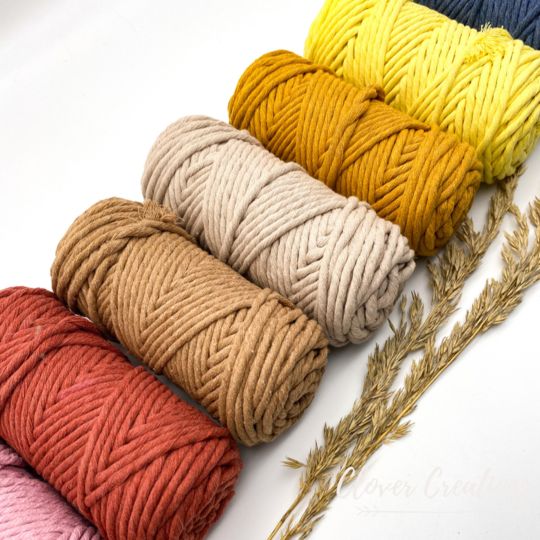Your cart is currently empty!
The Role of Macramé in Contemporary Art Installations
In recent years, macrame has transcended its traditional role as a craft to become a powerful medium in contemporary art installations. Once primarily associated with bohemian home decor and DIY fashion, macrame is now being embraced by modern artists for its versatility, texture and organic aesthetic. The revival of macrame in contemporary art reflects a wider shift towards handmade, tactile creations in a digital world where artists are looking for ways to connect with materiality and craft. One of the reasons macramé has found a place in contemporary art installations is its inherent sculptural quality. The technique of tying ropes or threads allows artists to create three-dimensional forms that interact with space in a unique way. This quality makes macramé an ideal medium for large-scale installations where the work can extend beyond flat surfaces and engage with the physical environment. Artists use macrame to create immersive spaces where viewers are invited to walk through, touch or experience the work in a multi-sensory way. The intricate patterns and flowing textures of macrame lend a natural, organic feel to these installations, creating a sense of movement and fluidity. In addition, macrame installations often reflect themes of sustainability and environmental awareness, as they are often made from natural materials such as cotton, hemp or jute. At a time when environmental issues are at the fore, many artists are drawn to macramé as a medium that aligns with their commitment to sustainability. The use of natural, biodegradable fibers in large-scale artworks serves as both a commentary on environmental issues and a celebration of traditional craftsmanship that favors slow, thoughtful creation over mass production. Macramé also resonates with contemporary art’s ongoing exploration of gender and identity. Historically, macramé was considered a domestic craft, traditionally associated with the work of women in the home. By recontextualizing macramé in the field of fine art, contemporary artists question and expand the boundaries of what constitutes art, questioning the division between “high” and “low” art forms. This reclaiming of macramé from its domestic roots is particularly strong in feminist art, where artists use the medium to subvert traditional gender roles and celebrate labor-intensive practices that have long been undervalued in the art world. The tactile, repetitive nature of macramé also lends itself to the concept of mindfulness and slow art. In a fast-paced world dominated by technology and instant gratification, macrame offers a slower, meditative process of creation that stands in contrast to digital. This emphasis on process and the artist’s hand in the work reflects a broader trend in contemporary art where viewers are increasingly interested in the craft, labor and intentionality of the art they encounter. The knots in macramé, each carefully tied, represent the artist’s time, effort and presence in the work. In both public and private installations, macramé has been used to transform spaces thanks to its soft, tactile beauty. From outdoor sculptures that interact with the natural landscape to indoor installations that redefine gallery spaces, macrame brings a human, handmade element to contemporary art. Its flexible nature allows artists to play with scale and create anything from delicate, small-scale works to massive installations that dominate a room. In conclusion, macrame’s role in contemporary art installations is a reflection of the art world’s renewed appreciation for craft, materiality, and the slow, mindful process of creation. It is a medium that bridges the gap between traditional craft and modern aesthetics, offering artists a way to explore themes of identity, sustainability and the physical experience of art. As macramé continues to evolve, it is a testament to the enduring power of handmade art in a world that increasingly values the connection between creator, material and viewer.
Recent Posts
- Modern Elegance Meets Gujarati Heritage: Macrame for New Year Decor
- History of Macrame Across Cultures: From Ancient Techniques to Modern Revival
- Threads of Tradition: Gujarat Macrame Ideas to Welcome the New Year
- Weaving New Beginnings: Gujarat Macrame Decor for a Stylish New Year
- Winter Wonderland: Using Macrame to Create a Cozy Christmas Vibe
Archive
Tags
.macrame art Artisan journey Beginners guide Bohemian home decor Community empowerment Custom macrame DIY macrame decor easy macrame projects Festive decoration Garba accessories Gujarat artisans Gujarat craft Gujarat handmade Gujarat India Gujarat macrame artisans Handicrafts handmade Handmade curtains Handmade decorations Handmade Gujarat Handmade products High-quality macrame Home decor home décor trends Innovative macrame Karva chauth home decor Local artisans Local craft Local products macrame art for beginners Macrame curtains Macrame Knots Macrame potli Macrame process Macrame products Macrame tools Macrame torans macrame Wall décor macrame wall hangings Materials for beginners Modern home decor Navratri fashion Personalized macrame Personalized products Sustainable Navratri decor

